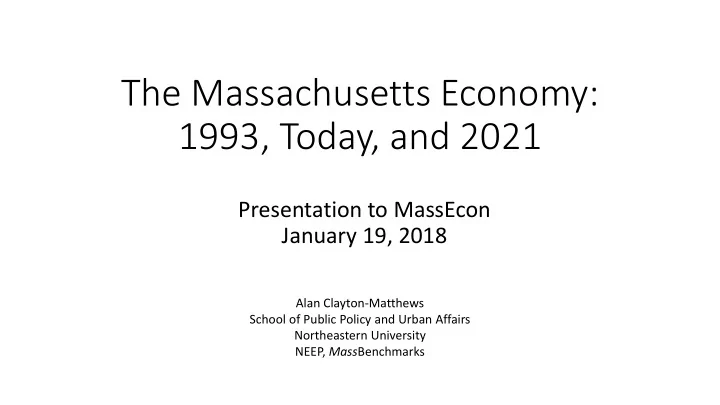

The Massachusetts Economy: 1993, Today, and 2021 Presentation to MassEcon January 19, 2018 Alan Clayton-Matthews School of Public Policy and Urban Affairs Northeastern University NEEP, Mass Benchmarks
1993
Payroll Employment, Massachusetts (thousands) 3,700 3,500 3,300 3,100 2,900 2,700 2,500 87 88 89 90 91 92 93 94 95 96 97 98 99 00 01 02 03 04 05 06 07 08 09 10 11 12 13 14 15 16
Massachusetts Unemployment Rate 10.0 9.0 8.0 7.0 6.0 5.0 4.0 3.0 2.0 1.0 0.0
Net Migration into Massachusetts 60,000 Number of Persons in Year Ending July 1 40,000 20,000 0 -20,000 not available not available -40,000 International -60,000 Domestic -80,000 919293949596979899000102030405060708091011121314151617181920 Source: Census Bureau: Population Estimates Branch
Labor Force Participation Rate, Massachusetts 70 69 68 67 66 65 64 63 62 76 77 78 79 80 81 82 83 84 85 86 87 88 89 90 91 92 93 94 95 96 97 98 99 00 01 02 03 04 05 06 07 08 09 10 11 12 13 14 15 16
Manufacturing has decreased as a share of Massachusetts payroll employment, while health services and professional services have increased. 1993 2016 Construction Construction Government Government 3% 4% Manufacturing 13% 14% 7% Manufacturing 15% Other Services Other Services 4% 3% Trade, Transportation, Utilities 16% Leisure & Hospitality Leisure & Hospitality 8% 10% Trade, Transportation, Utilities Information 18% 3% Health & Social Services Finance 13% 6% Health & Social Services Information 17% 3% Education Finance 4% Professional Services 7% Education Professional Services 15% 5% 12%
Educational Attainment Percent of Resident Population 25 Years and over with at Least a Bachelor’s Degree, 1940-2015 Source: U.S. Census Bureau; 1940-2000: Decennial Census; 2005-2015: American Community Survey, 1-year estimates 8
Today
Growth in Real Product, Massachusetts vs. U.S. Source: U.S., Bureau of Economic Analysis (BEA); Massachusetts: 10.0 9.2 through 2017Q1, BEA; 2017Q2 and later, MassBenchmarks. 8.0 Quarterly Growth at Annual Rates (%) 5.9 6.0 4.9 4.9 Projected 3.9 4.0 3.3 3.3 3.2 3.1 3.0 3.0 2.8 2.7 2.2 2.0 1.8 1.1 1.6 2.0 1.2 0.6 0.5 0.2 0.0 -1.1 -2.0 -2.0 -4.0 2015 2016 2017 2018 Massachusetts U.S.
Economists see corporate tax changes as a bigger “game changer” than the personal income tax changes.
Bachelor’s Degree Status Share of the Population 25 and over with at Least a Bachelor’s, 2005-2015 Source: U.S. Census Bureau, American Community Survey, S1501 (Educational Attainment), 1-year estimates; UMDI analysis Note: The Boston-Cambridge Region consists of Middlesex and Suffolk counties. 12
Sector Concentrations by Region Sector Strength in Boston-Cambridge Region and the Rest of State, 2015 Boston-Cambridge Region Rest of State Source: U.S. Census, County Business Patterns; UMDI analysis Note: The Boston-Cambridge Region consists of Middlesex and Suffolk counties. 13
Fertility Rate: Births per 1,000 Women, by Age, 2013-2015 140 Source: National Center for Health Statistics (NCHS) 120 100 80 60 40 20 Massachusetts U.S. 0 15 16 17 18 19 20 21 22 23 24 25 26 27 28 29 30 31 32 33 34 35 36 37 38 39 40 41 42 43 44
Mortality Rates per 100,000 Population, 2013-15 100,000.00 10,000.00 1,000.00 100.00 10.00 1.00 New England U.S.
Labor force participation rates are higher in Massachusetts at all age cohorts except for the college-aged. Labor Force Particpation Rates, Females, Last 48 Months Labor Force Particpation Rates, Males, Last 48 Months 100 100 Source: Current Population Survey 90 90 80 80 70 70 60 60 50 50 40 40 30 30 20 20 10 10 0 0 16-19 20-24 25-34 35-44 45-54 55-59 60-61 62-64 65-69 70-74 75-79 80+ 16-19 20-24 25-34 35-44 45-54 55-59 60-61 62-64 65-69 70-74 75-79 80+ MA U.S. MA U.S.
On net, Massachusetts’ population growth is boosted by migration, yet more people leave the state than come to Massachusetts from other states.
Immigration is key to the state’s future labor force growth. Average Annual Net Migration by Age, Massachusetts, 2011-2015 6,000 Source: American Community Survey, PUMS; calculations by author. 5,000 4,000 3,000 2,000 1,000 0 <15 15-19 20-24 25-29 30-34 35-54 55-64 65+ -1,000 -2,000 -3,000 -4,000 Domestic Domestic + International
2021
Labor force growth will slow, constrained by an aging population. Population and Labor Force Growth, Massachusetts (Percent growth from prior year) 1.8% Souce: Census Bureau, Bureau of Labor Statistics (2014-16); NEEP (2017-21) 1.6% 1.4% 1.2% 1.0% 0.8% 0.6% 0.4% 0.2% 0.0% 2014 2015 2016 2017 2018 2019 2020 2021 Population Labor Force
Despite attaining a full-employment economy… Unemployment Rate, Massachusetts Source: 2011-2016: BLS; 2017-2021: NEEP 8.0 7.0 7.2 6.7 6.6 6.0 5.7 5.0 4.8 4.0 3.9 3.7 3.7 3.7 3.7 3.7 3.0 2.0 1.0 0.0 2011 2012 2013 2014 2015 2016 2017 2018 2019 2020 2021
…employment growth will be constrained by the number of available workers. Total Payroll Employment, Percent Growth from Prior Year 2.5% 2.0% 1.5% 1.0% 0.5% Source: Federal Reserve Board (U.S.), NEEP (Massachusetts) 0.0% 2014 2015 2016 2017 2018 2019 2020 2021 Massachusetts Payroll Employment U.S. Civilian Employment
Construction will be the fastest growing sector, but health services and skilled business sectors will add the most jobs. Average Annual Growth by Employment Sector, 2016-2021, Massachusetts Source: NEEP Total Nonfarm employment (000's) 0.9% Construction 1.7% Manufacturing -0.4% Trade, Transportation, Utilities 0.5% Information 0.3% Financial Activities 0.8% Professional & Business Services 1.3% Education & Health Services 1.4% Leisure & Hospitality 0.8% Other Services 0.9% Government 0.5% -0.5% 0.0% 0.5% 1.0% 1.5% 2.0%
Improvements in productivity will enable output and incomes to grow faster than employment. Growth in Output per Payroll Worker, Massachusetts Source: 2012-2016: BEA, BLS; 2017-2021: NEEP 2.0% 1.7% 1.6% 1.5% 1.5% 1.3% 1.1% 1.0% 0.9% 0.5% 0.3% 0.2% 0.0% 2012 2013 2014 2015 2016 2017 2018 2019 2020 2021 -0.3% -0.5% -1.0% -1.5% -1.8% -2.0% -2.5%
Recommend
More recommend